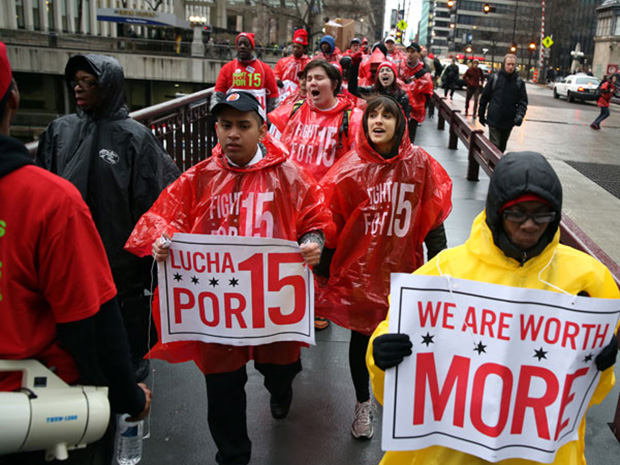
By Anna Lippincott.
There is a push by liberals to increase the minimum wage. President Obama proposes to boost the federal minimum wage to $10.10 per hour, and groups such as "Fight for $15" are demanding a $15 per hour minimum wage for low-skilled workers.
But while increasing the minimum wage may seem like the ideal solution to tackle poverty, even a slight increase has adverse effects on the entire economic ladder, from business owners to wage-earners. Women, who are a rapidly growing powerhouse in the workforce, will see firsthand how an increased minimum wage can teeter their ladder.
For the female business owner
According to census data, women own 28.7 percent of all nonfarm businesses. Since 1997, the number of female-owned firms has grown by 59 percent—1.5 times the rate of businesses overall. With female-owned businesses growing at an exponential rate, a minimum wage increase would have an adverse effect not only on current business owners, but also on women trying to create businesses.
A federal minimum wage increase stretches funds for business owners who are forced to either cut worker hours or lay off workers altogether. Increased wage advocates neglect to acknowledge businesses have a budget and a set amount of money with which to work. If employees start making double their current hourly salaries, that extra money has to come from somewhere, and usually that somewhere is from extended hours or a greater number of employees. While 38 percent of business owners claim they will be forced to lay off employees if there is a wage increase, the other 60 percent will remain stagnant in their current employment numbers. That means no new hiring and no potential for expansion.
In a 2013 Washington Post article, chief economist for the National Federation of Independent Business William Dunkelberg said, "The minimum wage is a major anti-jobs policy." He claimed, "Law of Demand always works: the higher the price of anything, the less that will be taken, and this includes labor."
Increased minimum wage cannot support business growth and even diminishes the likelihood businesses will succeed. In the months since Seattle adopted $15 minimum wage, for example, small business owners are already unable to keep up with the spiked wage inflation. According to The Seattle Times and Forbes, restaurants have been forced to raise prices and "source poorer ingredients." In the area, small businesses—restaurants especially—are closing at a higher rate than normal. Washington Restaurant Association CEO Anthony Anton told Forbes, "It's not a political problem; it's a math problem."

For the female minimum wage worker
But what about the women on the other side of the desk? After all, 59.1 percent of minimum wage-earners are female, and of that number, over 17 percent are full-time employees, according to the 2014 Bureau of Labor Statistics. Contrary to popular belief, these wage workers seldom advantage from an increase in minimum wage.
As the minimum wage increases, the prices of goods increase, and minimum wage workers find themselves back at square one. This inflation system does not impact moderate to expensive goods, which are oftentimes out of minimum wage earners' reach, but it does increase the cost of everyday items such as coffee and cosmetics. When the federal minimum wage was reset in 2009, the price of goods jumped. According to the Consumer Price Index, basic goods saw 2.9 percent inflation in 2009. That is a significant difference compared to 0.1 percent inflation the previous year.
Moreover, an arbitrary hike in the minimum wage creates a disincentive for low-income workers to acquire additional skills that would enable them to move up economic ladder.
Dr. Brian Baugus, an economics professor at Regent University, says that when discussing the minimum wage, "we are not talking about what a person is worth; we are talking about what their skills are worth." When minimum wage workers claim they are worth more than the minimum wage, they ignore the reality that a wage reflects the value of the skills they bring to a business. Increasing their skill value increases their wage value, something an artificial minimum wage increase cannot accomplish.
Instead of focusing on raising the minimum wage, we should be focusing on getting women out of the minimum wage cycle. Men traditionally take advantage of trade jobs, which require less formal education but pay well over the minimum wage. Unfortunately, these jobs still do not appeal to women, and very few enter trade industries, leaving less-educated women stuck in non-trade minimum wage jobs. This only furthers a pay gap between men and women.
Some call for fixing the gender pay gap while simultaneously calling for an increase in the minimum wage. According to Baugus, however, "the two go hand in hand, and by repeatedly increasing the minimum wage, we are keeping low-skilled women stuck in the cycle."

For…all other females
While there are obvious effects on female business owners and minimum wage earners, increasing the hourly minimum wage also affects all working women. They pay directly and indirectly as they buy the same basic goods and services whose prices are inflated by the minimum wage increase. According to CNN Money, those typically not affected by minimum wage have the potential to see an increase in their personal vendors' goods and services, such as the cost of snow plowing. These wage-earners may be able to pay more for inflated goods, but their salaries will be worth less over time.
While increasing the federal minimum wage may seem a good solution in theory, it has a negative ripple effect that impacts women on every rung of the economic ladder. Women who enter the business field will find that their personal economic growth is stunted as inflation of everyday goods and services eats at their wages, and low-skilled women, who account for over half of all minimum wage workers, will find fewer opportunities to gain the skills necessary to advance up the economic ladder.
Anna Lippincott is a CBLPI summer intern.
